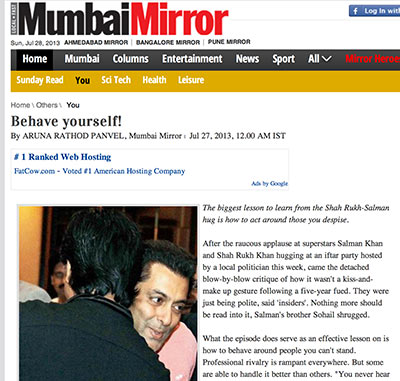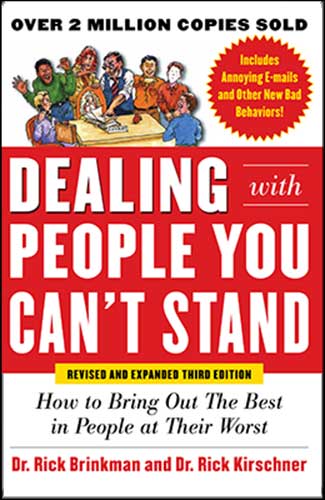I performed a webinar out of my own green screen studio for The Executive Roundtable recently. It was about the following.
Dealing with difficult people is something that everyone does on a regular basis. Leaders, in particular, may find themselves trying to manage and motivate people that they find challenging. But what makes some people more challenging than others? People often ask me what type of behavior is the most difficult to deal with. The answer isn’t that straightforward.
From my experience, here’s a list of the 10 most unwanted communicators:
The Tank
- : confrontational, pointed, and angry; the ultimate in pushy and aggressive behavior.
The Sniper
- : rude comments, biting sarcasm, rolling of the eyes.
The Grenade
- : brief calm followed by unfocused ranting and raving.
The Know-It-All
- : low tolerance for correction and contradiction.
The Think-They-Know-It-All
- : able to fool enough people that they are right.
The Yes person
- : eager to commit without thinking things through, which leads to resentment.
The Maybe person
- : procrastinates in the hope that a better choice will present itself.
The Nothing person
- : no verbal feedback, no nonverbal feedback. Nothing.
The No person
- : fights a never ending battle for futility; defeating ideas with a single syllable.
The Whiner
- : perfection is their standard, and no one and nothing measures up to it.
When people ask who the most difficult person is, I know that they’re secretly hoping I’ll tell them that the most problematic behavior is, in fact, the one exhibited by their #1 “problem” person. After all, it would validate that they are dealing with a jerk … and that they are not responsible for the problem.
But the truth is that difficulty is in the eye of the beholder: If you don’t know how to handle a behavior, it will be challenging for you. Because everyone reacts to thorny people differently, the behaviors that drive one person crazy won’t affect another person at all.
I recently spoke for a group of 75 people, 74 of whom were attending to learn how to deal with one “Tank” vice-president. A lone dissenter stood up and told her colleagues, “I don’t see what the problem is you people have with him. He’s a no-brainer to deal with.” Because she was wired differently than the rest, his behavior didn’t annoy or intimidate her.
Everyone has some skill handling certain behaviors. Other behaviors make us absolutely crazy because we’re missing the knowledge and/or attitude needed to successfully deal with the “problem” behavior. That’s where it pays to be a Conscious Communicator. By paying attention to what works — and what doesn’t — in human interaction, you can expand your communication skill set and achieve greater harmony with the people around you.
Which Behaviors Are Difficult for You?
In general, people who exhibit Get-It-Done behaviors are driven crazy by whiny or wishy-washy behaviors, because neither of these behaviors produces results. Whiners get nothing done because they are too busy wallowing in self-pity. Likewise, wishy-washy people accomplish little because they are fabulous at making commitments — and not keeping them. On the other hand, people who are friendly and desire harmony are intimidated by aggressive Tank-style behavior. People who are more expressive and emotional are driven crazy by Nothing people, who tend to be quiet and withdrawn, and vice versa.
Avoid or Play Nicely? Avoidance can be a valid strategy when dealing with people exhibiting difficult behaviors. After all, dealing with a difficult behavior takes a lot of work, so you must ask yourself if the relationship or job is worth the energy you must spend dealing with the problem person. If it’s not worth the price, it might be easier to leave the situation … or to get the other person to leave.
Unfortunately, leaving or otherwise avoiding a situation is not always possible. Perhaps you don’t want to quit your job … or your problem person is a close relative. In this scenario, you have to change your attitude, a process that starts by focusing on how you would benefit by changing your own behavior or attitude. When you successfully learn how to handle a difficult behavior, you’re doing yourself a favor — not only this time, but every time you encounter that behavior.
For people in leadership positions, learning to successfully deal with all problem behaviors is extremely beneficial. A leader’s job is to bring out the best in others, as well as to orchestrate a successful working environment, which means you can’t afford to have a difficult behavior destroying the morale or productivity of your team. Over the course of a career, you will work with all different types of people. Knowing how to deal with all of them gives you a competitive edge over colleagues who don’t practice Conscious Communication.








 Time Magazine Business online quotes our book Dealing With People You Can't Stand, How to Bring Out the Best in People at Their Worst (Brinkman & Kirschner, 2012 McGraw-Hill) with advice on how to deal with tough behaviors in the business world.
Visit the
Time Magazine Business online quotes our book Dealing With People You Can't Stand, How to Bring Out the Best in People at Their Worst (Brinkman & Kirschner, 2012 McGraw-Hill) with advice on how to deal with tough behaviors in the business world.
Visit the 
 There are three parts to the Rules of Non-Engagement: Before, During and After. In the last post we looked at how to prepare yourself before the family event. In the next few posts we will look at what you can do in the "during" phase.
DURING STAGE:
There are three parts to the Rules of Non-Engagement: Before, During and After. In the last post we looked at how to prepare yourself before the family event. In the next few posts we will look at what you can do in the "during" phase.
DURING STAGE: Everyone can use more time. The truth of it is, there is no time. There is only right here and "Now." When you woke up it was "Now." As you read this it is "Now." And in an hour it will still be "Now." In each precious moment of Now many things will ask for your attention. They will not all fit in the here and now. What you choose to allow in your Now quickly becomes your past. Success and fulfillment is making choices in your Now Moments that are based on your highest priorities.
To create more time in your life the first step is finding out what you are "saying Yes to" in the Now moment. Because every time you are saying "Yes" to something in the here and now, you are also saying "No" to a whole lot more.
Everyone can use more time. The truth of it is, there is no time. There is only right here and "Now." When you woke up it was "Now." As you read this it is "Now." And in an hour it will still be "Now." In each precious moment of Now many things will ask for your attention. They will not all fit in the here and now. What you choose to allow in your Now quickly becomes your past. Success and fulfillment is making choices in your Now Moments that are based on your highest priorities.
To create more time in your life the first step is finding out what you are "saying Yes to" in the Now moment. Because every time you are saying "Yes" to something in the here and now, you are also saying "No" to a whole lot more.